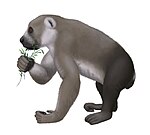The Primates Portal A primate is a member of the biological order Primates, the group that contains lemurs, the aye-aye, lorisids, galagos, tarsiers, monkeys, and apes, with the last category including great apes. With the exception of humans, who inhabit every continent on Earth, most primates live in tropical or subtropical regions of the Americas, Africa and Asia. Primates range in size from the 30-gram (1 oz) pygmy mouse lemur to the 200-kilogram (440 lb) mountain gorilla. According to fossil evidence, the primitive ancestors of primates may have existed in the late Cretaceous period around 65 mya (million years ago), and the oldest known primate is the Late Paleocene Plesiadapis, c. 55–58 mya. Molecular clock studies suggest that the primate branch may be even older, originating in the mid-Cretaceous period around 85 mya. Primates exhibit a wide range of characteristics. Some primates do not live primarily in trees, but all species possess adaptations for climbing trees. Locomotion techniques used include leaping from tree to tree, walking on two or four limbs, knuckle-walking, and swinging between branches of trees (known as brachiation). Primates are characterized by their large brains relative to other mammals. These features are most significant in monkeys and apes, and noticeably less so in lorises and lemurs. Many species are sexually dimorphic, which means males and females have different physical traits, including body mass, canine tooth size, and coloration.
Selected article
Archaeoindris fontoynontii is an extinct, giant lemur and the largest primate known to have evolved on Madagascar, comparable in size to a male gorilla. It belonged to a family of extinct lemurs known as "sloth lemurs" (Palaeopropithecidae), and because of its extremely large size, it has been compared to the extinct ground sloths of North and South America. It was most closely related to Palaeopropithecus, the second largest type of sloth lemur. Along with the other extinct sloth lemurs, Archaeoindris was related to the living indri, sifakas, and woolly lemurs, as well as the recently extinct monkey lemurs (Archaeolemuridae). It probably became extinct recently, around 350 BCE.
Its remains have been found at only one location: Ampasambazimba, a subfossil site in central Madagascar. The skeleton of Archaeoindris was massive and robust, and shared many traits with that of Palaeopropithecus. The arms were longer than the legs, but no hand or foot bones have been found for comparison with the other sloth lemurs. Size estimates based on the limited remains have varied widely, ranging as high as 244.1 kg (538 lb), but the most thorough statistical investigation estimates a mass of 160 kg (350 lb). There are varying opinions about the way Archaeoindris moved in its environment, ranging from tree-dwelling to ground-dwelling. Its skeleton suggests it was a deliberate climber that visited the ground to travel. The diet of Archaeoindris was mostly leaves, and its habitat—prior to human arrival—was a mix of woodlands, bushlands, and savanna, rich in lemur diversity. Although it was a rare lemur, it was still extant when humans first arrived on Madagascar, and it would have been vulnerable to hunting and habitat loss. Selected picture Emperor tamarins inhabit tropical rain forests, living deep in the forest and also in open tree-covered areas. This diurnal species walks or runs quadrupedally through the forest, spending the majority of its days in the trees with quick, safe movements and broad jumps among the limbs. CategoriesSelected species Least Concern (IUCN 3.1)|Least Concern Geoffroy's tamarin (Saguinus geoffroyi), also known as the Panamanian, red-crested or rufous-naped tamarin, is a tamarin, a type of small monkey, found in Panama and Colombia. It is predominantly black and white, with a reddish nape. Diurnal, Geoffroy's tamarin spends most of its time in trees, but does come down to the ground occasionally. It lives in groups that most often number between three and five individuals, and generally include one or more adults of each gender. It eats a variety of foods, including insects, exudates, fruits and other plant parts. Insects and fruits account for the majority of its diet, but exudates are also important. But since its teeth are not adapted for gouging trees to get to the sap, it can only eat exudates when they are easily available. Although a variety of reproductive methods are used, the most common is for a single adult female in the group to be reproductively active and to mate with multiple adult males in the group. After a gestation period of about 145 days, she gives birth to either a single infant or twins. Males contribute significantly to care of the infants. Sexual maturity is reached at about 2 years, and it can live up to 13 years. Geoffroy's tamarin is classified as "Least Concern" by the IUCN. Did you know?
Primate lists
WikiProjectsThings to do
Associated WikimediaDiscover Wikipedia using portals |
© MMXXIII Rich X Search. We shall prevail. All rights reserved. Rich X Search

















